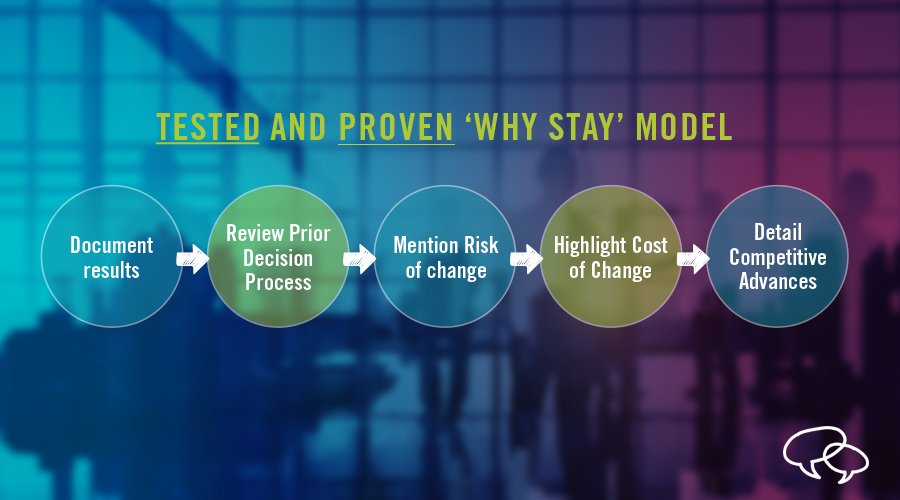
A provocative message is marketing gold when you’re trying to acquire new customers with a great “Why Change” story. Research proves it.
But it’s a very different story when you apply that same approach to renewal conversations or your “Why Stay” message. A Corporate Visions study I wrote about recently revealed that the provocative messaging approaches so in vogue today aren’t effective in a renewal context. In fact, they could even backfire when you are the incumbent and trying to secure a renewal contract.
What that study found is that the best approach for retaining customers involves reinforcing four specific decision-making factors that cause customers to favor their status quo over doing something new. Those factors are preference stability, perceived cost of change, anticipated blame/regret, and selection difficulty.
But here’s the question we wanted to get to the bottom of in a follow-up study: Is there a specific messaging framework that’s best-suited to telling the most compelling renewal story—reinforcing the status quo bias and encouraging customers to renew with you?
As it happens, there is. The follow-up study, conducted with social psychologist Dr. Zakary Tormala, confirmed that you need to do two things well to make the biggest impact with your renewal messaging:
- First, you need to document the specific results of your partnership and share those first before trying to affirm why you were, and continue to be, the right choice for your customer.
- You then need to provide more expanded detail—as opposed to less—about the recent advances in your solution that are helping your customers keep pace with the market and anything your competition is offering.
Here’s how we set up the study.
Testing the Best Framework for ‘Why Stay’
For this online experiment, we recruited 380 individuals. The participants were instructed to imagine that they ran a small business and that about two years ago they’d signed up with a 401(k) benefits provider to help promote their company’s retirement plan to employees. The hope was that getting more employees signed up would boost employee satisfaction with the company and increase employee retention.
Participants were told to imagine that two years ago, only 20% of their employees subscribed to the 401(k) plan. In the two years since then, participation had risen to 50%, a positive sign, but still short of the 80% goal. During that same period, employee retention rates had improved, but it was difficult to say how much of that could be attributed to the company’s promotion of its 401(k) benefits plan.
Following this background description, participants read a message from their 401K provider, in which they were told to imagine they were trying to decide whether to renew and continue working with that provider. The message represented the provider’s attempt to persuade them to do so, focusing on reinforcing the status quo bias, emphasizing how much effort went into selecting the current provider and playing up the risks and costs associated with changing to a new provider.
Importantly, though, the message varied along two key dimensions across four experimental conditions into which participants were evenly divided. The first dimension was whether the provider documented successful results before or after reinforcing the status quo. The second dimension was whether the provider gave more or less explicit detail on the recent advances it had made.
All told, the study included four different message conditions, each with a different combination of information order and level of detail.
After receiving the pitches, participants answered a series of questions designed to assess switching intentions, willingness to pay, trust, and message quality. Across these dimensions, the “document results first” and “more detail” messages proved more persuasive than the “status quo first” and “less detail” messages. While there were differences across measures in terms of which effect reached statistical significance, the overall pattern of results points to the greater effectiveness of documenting results at the beginning of the message and using more explicit detail in highlighting recent advances.
The overall pattern of findings reveals that documenting results at the outset of your message (before trying to affirm that you, and continue to be, the right choice) and providing more explicit detail about your progress (as opposed to less) will give you significant messaging advantages in the areas of:
- Minimizing switching intentions;
- Increasing willingness to pay;
- Improving trust; and
- Enhancing perceptions of quality
For an in-depth look at the study’s findings, check out the research brief.
Below is the basic message framework of the winning condition in the study, which tested four different renewal messages (varying in structure and level of detail) aimed at convincing business partners to remain with their current 401k provider. The parts of the framework correspond to the four causes of the status quo, mentioned above, which the renewal message sets out to reinforce.
Winning Condition
Document Results – You have made great progress on your goals over these last two years. You’ve seen 401k participation grow from 20 percent to 50 percent. Your employee satisfaction scores are up, and you’ve said some employees have even taken the time to thank you for the changes you’ve made. In addition, your employee retention rates have started to improve, which you said was the ultimate goal of making these changes.
Stabilize preferences – When you signed up two years ago, you really did your homework and looked at a lot of options before getting your entire team to come to a consensus and choose our company. It was a long process that involved a lot of people, but you ultimately arrived at a big decision to bring this program on board.
Anticipate Regret/Blame – As you look at making a renewal decision, it’s important to realize that you are at a critical point in this journey and that it’s important to maintain momentum to achieve your ultimate participation and retention goals. Any change to the program at this point could create an unnecessary risk of losing the positive gains you’ve made.
Mention Perceived Cost of Change – Not to mention that bringing in another vendor would require you to invest time in getting them up to speed and money on implementation costs and other changes that you won’t have to spend if you continue working with us.
Reinforce Selection Difficulty – We’ve also continued to update and tweak your program over the last two years to make sure you are keeping pace with anything else available in the market today. Specifically, you will get two new features designed to help improve your goals of employee participation and satisfaction: The first is a monthly report that shows how many tax dollars your 401k participants saved versus those who aren’t in the 401k. You can share this with your employees monthly to provide a gentle nudge to get into the program for the tax benefits. Second, we’ve also added a new smartphone app with retirement planning calculators and budgeting tools to help your employees make more informed decisions, and feel like they’re making progress on their goals.
You’re making great progress. Stick with our program for another two years, and I know you’ll get to your 80% participation goal and further increase your employee retention rates.
Want to see an overview of additional Corporate Visions research on renewal messaging, and see how companies are handling the customer retention message today? Check out our State of the Conversation Report.
This article originally published in CMO.com





